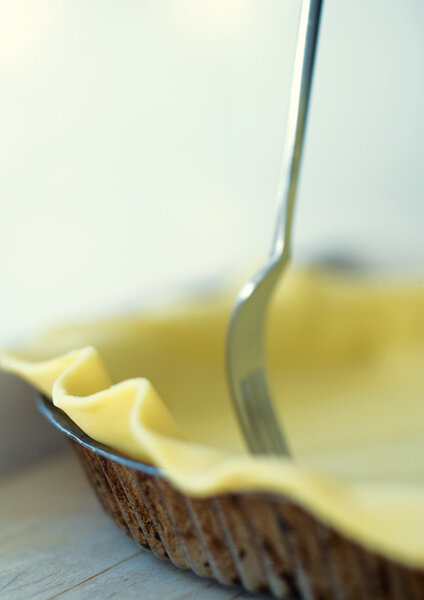Perfect pie crust: Flakiness required
Loading...
While most men think about football and fishing, I think about food – pan-seared venison, warm chocolate cake topped with vanilla bean ice cream, English tea with scones, éclairs...
Mention food or seduce me with an aromatic wisp of some culinary masterpiece, and I metamorphose from a reserved man to a highly expressive foodie, eager to describe his latest culinary experience.
You would think, as a result of my love for food, I would enjoy cooking. But I don't. For years, I've kept it to a minimum – until the eve of the great February 2010 Washington, D.C., blizzard.
Snowed in for a week with a professional cooking school chef as my houseguest, I found myself suddenly submitting to an unnatural urge to prepare from scratch a flaky butter pie crust. I knew, if successful, a new world would open up to me (i.e., spinach quiche, fruit pies, custard tarts, and much more). Therefore, I was ready and willing when my chef friend turned into a drill sergeant and began to teach me techniques for preparing pie crust.
"The butter must be at room temperature; the flour enriched. No, Joe, stretch the dough with the heel of your palm. The heel, Joe, not your entire hand. That's it. Now scrape together the ingredients with the pastry cutter, and stretch the dough again. Perfect. Stretch, scrape together, stretch, scrape together," she repeated emphatically during five such exercises. "That's it. Enough. Don't overwork the dough. Little pieces of butter should remain visible."
After rolling out the dough into a thin, round sheet, I discovered to my surprise that I was able to lift it easily and place it into the pie pan without tearing it. I was thrilled. I remembered all the pie crusts that I had once made. I would blend the ingredients together into a satiny ball and stretch them thin with a rolling pin. Then I would peel the sticky dough from the counter and paste it into a pie pan piece by piece.
For years, I had naively believed that the only way to make a crust was to mix the right ingredients and bake them at the right temperature. But according to my instructor, there was more to it. You needed technique, too.
As easy as her crust was to prepare, it lacked the buttery flakiness I always preferred. For a solution, I turned to a former neighbor who cooks like an angel. Armed with her recipe, I began experimenting, adjusting the measurements to meet my taste preference.
During the next weeks, I prepared about a half-dozen quiches, which I served to fussy friends. Based on their verdict and my own, I have created what I believe is a tasty crust, almost as good as a shortbread. And the beauty of it is, it's easy to prepare – with a little technique and a generous amount of butter.
Makes 9-inch crust
1-1/2 cups of all-purpose flour
1 teaspoon each of salt and sugar (to taste)
1-1/2 sticks of unsalted butter, room temperature
1 to 2 tablespoons cold water
Place the flour, salt, and sugar on a cutting board or counter. Add the butter to the center. Use a pastry cutter to chop the butter into small pieces. Mix the butter and flour mixture together, using the pastry cutter, until crumbly. Add the water to the center of the mixture and repeat, using the pastry cutter.
Create a ball from the crumbly dough. Stretch the dough using the heel of your hand. With the pastry cutter, gather the dough together into a ball, then stretch it again with the heel of your palm. Avoid overworking the dough. You are finished when you only have small chips of butter scattered throughout the dough. Shape dough into a disk, wrap it in plastic, and refrigerate it for an hour.
Sprinkle the counter and the top of the cold dough with flour for easy rolling. (Sprinkle as frequently as necessary to avoid sticking.) Roll the dough, working from the center; maintain an even weight on the rolling pin.
Loosen the dough carefully from the counter with a pastry scraper (or spatula) after shaping it into a thin sheet. Carefully place it into a false-bottom pie pan. Trim the top of the pie crust and shape edges to liking.
Place a sheet of aluminum foil inside the pie crust and fill the foil with pie weights. Bake at 350 degrees F. for about 15 to 20 minutes – or until the dough is brown. (Note: The dough, once prepared, can be frozen.)
1 small onion or 1 cup of sliced onion
Olive oil
6 oz. package of fresh spinach, washed and chopped
1/4 cup fresh dill
4 eggs
1 cup heavy whipping cream
1 teaspoon nutmeg
1 teaspoon white pepper
1/2 teaspoon salt
1/4 cup Parmesan cheese
1/2 cup feta
Sauté onions in olive oil until translucent. Add chopped spinach and mix, then add the dill. Heat briefly. Remove from heat and set aside.
Mix together eggs, cream, nutmeg, pepper, and salt.
Layer bottom of 9-inch pie crust with Parmesan and feta cheeses, then add spinach mixture, and top with liquid ingredients.
Place in a preheated oven (350 degrees F.) and bake until golden on top, about 25 minutes. Let cool for 15 minutes before serving.





